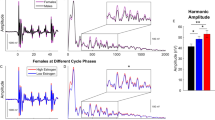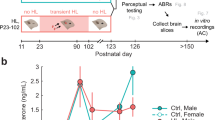Abstract
Recent discoveries show that behaviourally relevant sensory experience drives the production of oestradiol — the classic sex steroid oestrogen — in auditory neurons in the adult brain of both males and females. This brain-generated oestrogen markedly enhances the efficiency of the neural coding of acoustic cues and shapes auditory-based behaviours on a timescale that is relevant for sensory processing and congruent with the action of rapid neuromodulators. These findings are re-shaping our current understanding of the mechanistic framework that supports sensory processing and the functional roles of hormones in the brain, and have implications for multiple health issues.
This is a preview of subscription content, access via your institution
Access options
Subscribe to this journal
Receive 12 print issues and online access
$189.00 per year
only $15.75 per issue
Buy this article
- Purchase on Springer Link
- Instant access to full article PDF
Prices may be subject to local taxes which are calculated during checkout


Similar content being viewed by others
References
Miranda, J. A. & Liu, R. C. Dissecting natural sensory plasticity: hormones and experience in a maternal context. Hear. Res. 252, 21–28 (2009).
Penton-Voak, I. S. et al. Menstrual cycle alters face preference. Nature 399, 741–742 (1999).
Mazzocco, M. M., Singh Bhatia, N. & Lesniak-Karpiak, K. Visuospatial skills and their association with math performance in girls with fragile X or Turner syndrome. Child Neuropsychol. 12, 87–110 (2006).
Arch, V. S. & Narins, P. M. Sexual hearing: the influence of sex hormones on acoustic communication in frogs. Hear. Res. 252, 15–20 (2009).
Gentner, T. Q. Neural systems for individual song recognition in adult birds. Ann. NY Acad. Sci. 1016, 282–302 (2004).
Nowicki, S. & Searcy, W. A. Song function and the evolution of female preferences: why birds sing, why brains matter. Ann. NY Acad. Sci. 1016, 704–723 (2004).
Pinaud, R., Fortes, A. F., Lovell, P. & Mello, C. V. Calbindin-positive neurons reveal a sexual dimorphism within the songbird analogue of the mammalian auditory cortex. J. Neurobiol. 66, 182–195 (2006).
Saldanha, C. J. et al. Distribution and regulation of telencephalic aromatase expression in the zebra finch revealed with a specific antibody. J. Comp. Neurol. 423, 619–630 (2000).
Tremere, L. A., Jeong, J. K. & Pinaud, R. Estradiol shapes auditory processing in the adult brain by regulating inhibitory transmission and plasticity-associated gene expression. J. Neurosci. 29, 5949–5963 (2009).
Jeong, J. K., Burrows, K., Tremere, L. A. & Pinaud, R. Neurochemical organization and experience-dependent activation of estrogen-associated circuits in the songbird auditory forebrain. Eur. J. Neurosci. 34, 283–291 (2011).
Jacobs, E. C., Arnold, A. P. & Campagnoni, A. T. Zebra finch estrogen receptor cDNA: cloning and mRNA expression. J. Steroid Biochem. Mol. Biol. 59, 135–145 (1996).
Metzdorf, R., Gahr, M. & Fusani, L. Distribution of aromatase, estrogen receptor, and androgen receptor mRNA in the forebrain of songbirds and nonsongbirds. J. Comp. Neurol. 407, 115–129 (1999).
Saldanha, C. J. & Coomaralingam, L. Overlap and co-expression of estrogen synthetic and responsive neurons in the songbird brain — a double-label immunocytochemical study. Gen. Comp. Endocrinol. 141, 66–75 (2005).
Remage-Healey, L., Maidment, N. T. & Schlinger, B. A. Forebrain steroid levels fluctuate rapidly during social interactions. Nature Neurosci. 11, 1327–1334 (2008).
Tremere, L. A., Burrows, K., Jeong, J. K. & Pinaud, R. Organization of estrogen-associated circuits in the mouse primary auditory cortex. J. Exp. Neurosci. 5, 45–60 (2011).
Yague, J. G. et al. Aromatase distribution in the monkey temporal neocortex and hippocampus. Brain Res. 1209, 115–127 (2008).
Yague, J. G. et al. Aromatase expression in the human temporal cortex. Neuroscience 138, 389–401 (2006).
Azcoitia, I., Yague, J. G. & Garcia-Segura, L. M. Estradiol synthesis within the human brain. Neuroscience 191, 139–147 (2011).
Tremere, L. A. & Pinaud, R. Brain-generated estradiol drives long-term optimization of auditory coding to enhance the discrimination of communication signals. J. Neurosci. 31, 3271–3289 (2011).
Remage-Healey, L., Coleman, M. J., Oyama, R. K. & Schlinger, B. A. Brain estrogens rapidly strengthen auditory encoding and guide song preference in a songbird. Proc. Natl Acad. Sci. USA 107, 3852–3857 (2010).
Remage-Healey, L., Dong, S. M., Chao, A. & Schlinger, B. A. Sex-specific, rapid neuroestrogen fluctuations and neurophysiological actions in the songbird auditory forebrain. J. Neurophysiol. 107, 1627–1631 (2012).
Vicario, D. S., Naqvi, N. H. & Raksin, J. N. Sex differences in discrimination of vocal communication signals in a songbird. Anim. Behav. 61, 805–817 (2001).
Gobes, S. M. & Bolhuis, J. J. Birdsong memory: a neural dissociation between song recognition and production. Curr. Biol. 17, 789–793 (2007).
Woolley, C. S. Acute effects of estrogen on neuronal physiology. Annu. Rev. Pharmacol. Toxicol. 47, 657–680 (2007).
Pinaud, R. et al. Inhibitory network interactions shape the auditory processing of natural communication signals in the songbird auditory forebrain. J. Neurophysiol. 100, 441–455 (2008).
Mello, C. V., Velho, T. A. & Pinaud, R. Song-induced gene expression: a window on song auditory processing and perception. Ann. NY Acad. Sci. 1016, 263–281 (2004).
London, S. E. & Clayton, D. F. Functional identification of sensory mechanisms required for developmental song learning. Nature Neurosci. 11, 579–586 (2008).
Mello, C. V. & Pinaud, R. in Immediate Early Genes in Sensory Processing, Cognitive Performance and Neurological Disorders (eds Pinaud, R. & Tremere, L. A.) 35–56 (Springer, 2006).
Hultcrantz, M. & Sylven, L. Turner's syndrome and hearing disorders in women aged 16–34. Hear. Res. 103, 69–74 (1997).
Jerger, J. & Hall, J. Effects of age and sex on auditory brainstem response. Arch. Otolaryngol. 106, 387–391 (1980).
Davis, M. J. & Ahroon, W. A. Fluctuations in susceptibility to noise-induced temporary threshold shift as influenced by the menstrual cycle. J. Aud. Res. 22, 173–187 (1982).
Walpurger, V., Pietrowsky, R., Kirschbaum, C. & Wolf, O. T. Effects of the menstrual cycle on auditory event-related potentials. Horm. Behav. 46, 600–606 (2004).
Golub, M. S., Germann, S. L. & Hogrefe, C. E. Endocrine disruption and cognitive function in adolescent female rhesus monkeys. Neurotoxicol. Teratol. 26, 799–809 (2004).
Coleman, J. R., Campbell, D., Cooper, W. A., Welsh, M. G. & Moyer, J. Auditory brainstem responses after ovariectomy and estrogen replacement in rat. Hear. Res. 80, 209–215 (1994).
Kim, S. H., Kang, B. M., Chae, H. D. & Kim, C. H. The association between serum estradiol level and hearing sensitivity in postmenopausal women. Obstet. Gynecol. 99, 726–730 (2002).
Maney, D. L., Cho, E. & Goode, C. T. Estrogen-dependent selectivity of genomic responses to birdsong. Eur. J. Neurosci. 23, 1523–1529 (2006).
Sanford, S. E., Lange, H. S. & Maney, D. L. Topography of estradiol-modulated genomic responses in the songbird auditory forebrain. Dev. Neurobiol. 70, 73–86 (2010).
Balthazart, J. & Ball, G. F. Is brain estradiol a hormone or a neurotransmitter? Trends Neurosci. 29, 241–249 (2006).
Saldanha, C. J., Remage-Healey, L. & Schlinger, B. A. Synaptocrine signaling: steroid synthesis and action at the synapse. Endocr. Rev. 32, 532–549 (2011).
Cornil, C. A. et al. Acute and specific modulation of presynaptic aromatization in the vertebrate brain. Endocrinology 153, 2562–2567 (2012).
Remage-Healey, L., Dong, S., Maidment, N. T. & Schlinger, B. A. Presynaptic control of rapid estrogen fluctuations in the songbird auditory forebrain. J. Neurosci. 31, 10034–10038 (2011).
Jeong, J. K., Tremere, L. A., Burrows, K., Majewska, A. K. & Pinaud, R. The mouse primary visual cortex is a site of production and sensitivity to estrogens. PLoS ONE 6, e20400 (2011).
Joels, M. & de Kloet, E. R. Effects of glucocorticoids and norepinephrine on the excitability in the hippocampus. Science 245, 1502–1505 (1989).
Karst, H. & Joels, M. Corticosterone slowly enhances miniature excitatory postsynaptic current amplitude in mice CA1 hippocampal cells. J. Neurophysiol. 94, 3479–3486 (2005).
Krugers, H. J., Hoogenraad, C. C. & Groc, L. Stress hormones and AMPA receptor trafficking in synaptic plasticity and memory. Nature Rev. Neurosci. 11, 675–681 (2010).
Peters, M., Simmons, L. W. & Rhodes, G. Preferences across the menstrual cycle for masculinity and symmetry in photographs of male faces and bodies. PLoS ONE 4, e4138 (2009).
Little, A. C., Jones, B. C. & Burriss, R. P. Preferences for masculinity in male bodies change across the menstrual cycle. Horm. Behav. 51, 633–639 (2007).
Phillips, S. M. & Sherwin, B. B. Variations in memory function and sex steroid hormones across the menstrual cycle. Psychoneuroendocrinology 17, 497–506 (1992).
Acknowledgements
We apologize to authors whose papers were not discussed here owing to the short format. We thank C. Woolley, D. Ferster (Northwestern University, Illinois, USA) and G. DeAngelis (University of Rochester, New York, USA) for comments on the manuscript and valuable discussions. The authors' work is supported by the US National Institutes of Health (grant R01-DC-010181), the US National Science Foundation (grant 1064684) and the Searle Leadership Fund (grant to R.P.).
Author information
Authors and Affiliations
Corresponding author
Ethics declarations
Competing interests
The authors declare no competing financial interests.
Related links
Glossary
- Rate coding
-
A neural coding scheme in which stimulus information is coded through changes in neuronal spiking frequency.
- Response gain
-
Sensitivity of a neuronal response to a constant set of inputs.
- Temporal coding
-
Multiple definitions of temporal coding exist, but here the term refers to a neural coding scheme in which information is coded through the precision in the timing of action potentials.
Rights and permissions
About this article
Cite this article
Pinaud, R., Tremere, L. Control of central auditory processing by a brain-generated oestrogen. Nat Rev Neurosci 13, 521–527 (2012). https://doi.org/10.1038/nrn3291
Published:
Issue Date:
DOI: https://doi.org/10.1038/nrn3291
This article is cited by
-
Endocannabinoid signalling is required for estrogen-dependent modulation of inhibitory transmission
Journal of Biosciences (2012)



